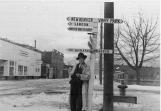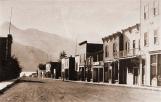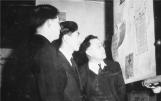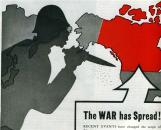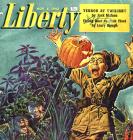1
The New Canadian (1938-2001) was a small newspaper of national, historic importance. Many Canadians do not know its story. It was the newspaper of the Nisei, the first Canadian-born generation of Japanese Canadians. Tom Shoyama served as New Canadian editor from 1939 to 1945. Mirroring the plight of the unfortunate Japanese Canadians it served, the paper moved from Vancouver to the small Kootenay "ghost town" of Kaslo, where 1200 Japanese Canadians were interned during and after the WWII years. Why was this little newspaper important to us all?1. It is the primary source document for the Japanese Canadian wartime experience. It leads us step by step through wartime injustices, evacuations, internments, confiscations, depatriation, and upheavals of the wartime diaspora of 22,000 Japanese Canadians.
2. Its editorial stance never wavered, anti-racist, pro-justice and pro-Canadian.
3. The Kaslo Years of the New Canadian provide a comprehensive look at "Ghost Town" life and was the vehicle for emergent Nisei literature.
4. Finally it championed their postwar fight for justice and Redress.
The Struggle for human rights and freedom is most eloquently told by those who have suffered its loss. The Japanese Canadians lost everything but their self respect in the war years and have been Canadian leaders in fighting racism ever since. Their experience reminds us that our "free country" has not always been free for all.
3
TOMMY SHOYAMA AT THE CROSSROADSTommy was at the crossroads in June 1944. The censors wanted to shutdown The New Canadian for criticizing the racist tendencies of Vancouver's mayor in the previous issue. After years of fighting for justice for Japanese Canadians, was it time to buckle under? No. Tom Shoyama's editorial in The New Canadian began:
REAFFIRMING A PURPOSE
Despite all the things that have been said and done since Pearl Harbor, and despite all the things that becloud the horizon, this Dominion Day serves as an appropriate time to re-affirm here the fundamental purpose for the existence of this Newspaper.
That purpose, simply, is to lift a voice and fight to establish the right and privilege of every citizen, irrespective of his racial origin, to walk with equal dignity, freedom and service amongst his fellow Canadians.
Tommy Shoyama ... from the Langham tape collection
"We had a sense of mission in the sense that it was very important to do everything we could to sustain morale. We had to tell people: Look, in spite of all these terrible things that have happened to you, stand on your own feet. Look within yourself to your own strength and self-respect and your own sense of dignity."
5
When The New Canadian started publishing on Front Street in November, 1942, Kaslo on the shores of Kootenay Lake became the centre of the Japanese Canadian world. News of friends and family members scattered to the winds, as well as official "proclamations" and government policy directives were available only through this paper.6
'Memories of Powell Street' Caricature by Frank Moritsugu as published in the The New Canadian.1943
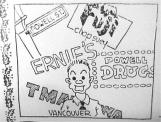
7
Before the wartime troubles, the First Issue of The New Canadian was published in 1938 in Vancouver. British Columbia was home to all but a handful of Canada's Japanese Canadians. Over 60% were Canadian born and English-speaking Nisei. Vancouver's Powell Street was the centre of the prewar community."We started a little weekly paper called the New Canadian, which became a voice crying out for equality in the wilderness." Frequent New Canadian contributor Muriel Kitigawa as cited in THIS IS MY OWN, Talonbooks, 1985, Roy Miki, ed.
powell street knows
all about those
who limp, run stagger or
walk
criss-cross, stop and talk
for echoes of laughter
whispers of pain
odour of burnt toast
exotic scent of chow mein
dissolve into the street in
midnight rain
that's how
powell st. knows
Mark Toyama's poem Powell Street as published in New Canadian in 1940, was viewed by many as the beginning of Nisei poetry.
8
The backdrop was racist. The "Japanese Problem" was part of the "Oriental Problem" and was stirred by the media of the day and the antagonism of such political pressure groups as the White Canada Association.The Legislative assembly of British Columbia (1935) was passing legislation that read, in part:
"Whereas the standard of living of the average Oriental is far lower than that of the white man, thus enabling him to live comfortably on a much lower wage than our white men:
and whereas the Orientals have invaded many fields of industrial and commercial activities to the serious detriment of our white citizens: …
Therefore be it Resolved, that this house go on record as being utterly opposed to further influx of Orientals into this Province…"
as cited by Harold Innis in The Japanese Canadians. University of Toronto Press, 1938.
10
"When Pearl Harbor wiped out our past, our homes, our community life, and our businesses, we clung to that paper, as we would to a spar, a raft, the beacon of a lighthouse … Our little weekly paper, the New Canadian , the only survivor of the shutdown orders on the local Japanese press, kept on repeating editorially: "Have Faith In Canada!"Keeping our faith was an uphill job, when our cars, radios, and cameras were impounded, our homes taken over and sold over our protests. When our freedom to move, to assemble, to work, to find homes, was curtailed, restricted and administrated by both the RCMP and a new office called the Japanese Division, Department of Labour."
Muriel Kitigawa as cited in THIS IS MY OWN, Talonbooks, 1985, Roy Miki, ed.
13
"It's hard to even think of the people's feelings towards the Nikkei people. It was the media that was responsible, and the politicians, too. There were three "wheeling and dealing" politicians at the coast who pushed the "back across the briny solution". They came into political prominence on these anti-Japanese issues. The media, particularly the Sun, was particularly harsh. The cartoons in those days pictured our skin to be like lemon and our eyes thin and slanted and we had big buck teeth.The slogan they pushed was "once a Jap always a Jap". It didn't matter that we had never seen Japan, didn't know that country or have any connection with it and that we were Canadians."
... Kaslo internee and long time resident, Aya Higashi from the Langham tape collection.
